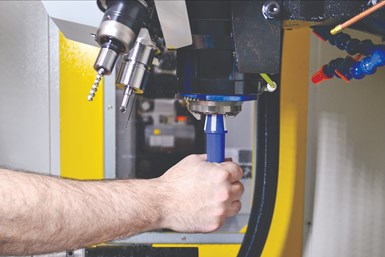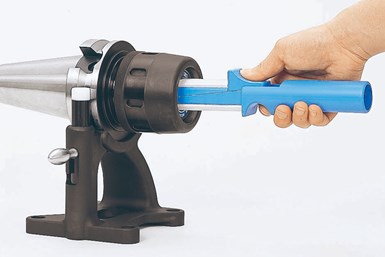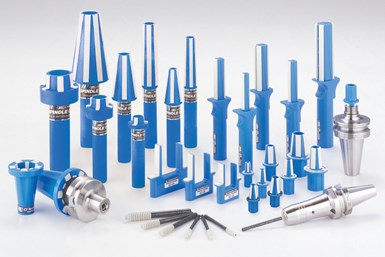How Diligent Are You About Toolholder, Spindle Cleanliness?
Appears in Print as: 'Tool Cleanliness is Quality Issue'
Big Kaiser offers insights in how to best clean and maintain cutting tool assemblies to ensure CNC machine tools operate at optimum performance.
#basics
Edited by Derek Korn

Spindle cleaners are a great tool to ensure cleanliness of tapered, polygon and HSK spindles.
Maintaining a clean interface between machine spindle and toolholder as well as toolholder and cutting tool is imperative to help maximize machining rigidity, precision and tool and toolholder life. Unfortunately, many shops are not proactive about cleaning spindles or tool holders, according to Alan Miller, engineering and product manager for Big Kaiser.
He notes that if toolholders and spindles are not properly or frequently cleaned, that can lead to increased runout and shorten the life of cutting tools. “And, in extreme situations, large swarf particles can be trapped in the mating surfaces and cause physical damage to a spindle or holder,” Miller says. “A good process would entail cleaning the spindles at the start and end of every shift. Tool holders should be completely disassembled and cleaned during the next tool setup. Each point of contact must be kept clean to maintain performance and avoid scrap or poor finishes which can result from misalignment or chatter.”
This cleaning is the responsibility of both machine operators and maintenance staff. “Machine operators should take a role in cleaning before and after each shift,” Miller says. “If there is a tool crib, the attendant should be taking the time to clean each tool holder and accessories with every setup.”

Bore cleaners are capable of cleaning small and large toolholder clamping bores to maintain high performance and accuracy.
Cleaning accessories can make these processes easier and more effective, such as the cleaning devices for toolholder tapers and tool clamping bores as well as machine spindles that Big Kaiser offers. “Cleaning with shop rags can be done, but it’s more difficult to get them properly into spindles or small collet bores,” Miller adds. “Also, cleaners with silicone wipers will move oil and dirt, but may not remove them from the surfaces.”
Big Kaiser’s devices require no cleaning agents. Instead, they use strips of absorbant synthetic leather to collect dirt and oil. Miller says while the devices might look dirty after the first use, they can continue to be used for as much as six months. If the cleaning surfaces become heavily contaminated or pick up swarf, they should be replaced.

A small buildup of particulate can throw off a whole operation or damage tooling and machine mechanics. Cleaners make it easy to get spindles and tooling in the best condition to perform exactly as desired over and over.
Also, dry machining cast iron and graphite can leave more residue on machines, tools and spindles. Miller suggests that extra systems such as vacuums and filters can reduce this issue. Cleaning toolholders in these situations would still be the same, but spindles may need more frequent attention.
Miller recommends that shops shouldn’t wait until they experience process consistency problems before looking for cleaning solutions. “These cleaning products can help, as will developing a shopwide cleaning process,” Miller says. “Once they figure out how difficult it is to use rags to get into tight places, they start looking for other options.”
What’s not an option is ignoring toolholder and spindle cleanliness. Maintaining a rigorous cleaning schedule is essential for sustaining performance and extending the tool life to maintain consistency. Cleaning accessories can help shops perform those chores quickly, easily and successfully every time to help improve productivity and maintain equipment.
RELATED CONTENT
-
5 Ideas for Continuous Improvement
These suggestions for manufacturing process improvements are based on Kaizen ideas that call for never-ending improvement from the entire organization.
-
7 Causes of Quench Cracking in Steel
Failures of steel parts in service or production occur infrequently. However, when steel parts fail, the consequences are dire. Here are seven ways that steel can fail as a result of quench cracking from heat treatment.
-
Deal Differently with Certainty, Risk and Uncertainty
Let's take a look at the differences between certainty, risk and uncertainty, examples of each, and how we make decisions when faced with these situations.



